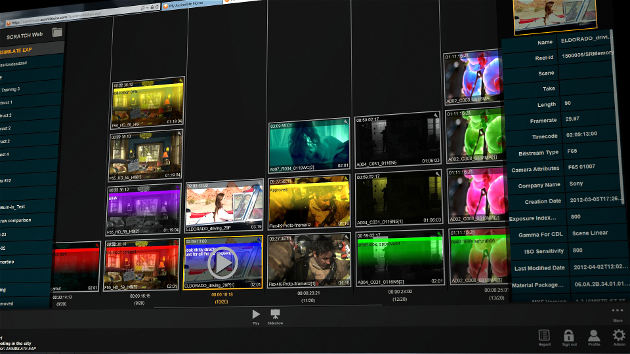V8.2 Updates Media Browser, Adds Live View Function, Supports VR360 Format for Oculus Rift and Similar Platforms
Assimilate released Scratch and Scratch Lab v8.2, implementing new features including updates to the Scratch media browser, a Live View function for capturing footage and metadata from a camera's SDI output, a Mac implementation of Vanguard Video's H.264 codec, and support for the VR360 file format for grading and compositing virtual-reality shots in real time.
"The common thread is metadata," Assimilate VP of Marketing Steve Bannerman told StudioDaily. "It's end-to-end workflow, carrying metadata from camera to master, and how you manage that workflow. Metadata is woven through everything."
When using Live View to bring in an SDI signal, Scratch artists can grade the camera feed and save the resulting looks in the Scratch Gallery, where they can be retrieved and applied later. Metadata from the shoot can be applied to keep track of which shots go with which looks, or to implement and globally manage naming conventions to make life easier for editorial.

Assimilate said Scratch v8.2 supports grading and compositing VR shots in real time with or without a headset.
The timing seems to be right to add virtual reality support, Bannerman said, especially with the production version of the Oculus Rift expected to ship to consumers in 2015 and the Samsung Gear VR and Google Cardboard also generating lots of interest. He described a busy day at this weekend's "jam-packed" Virtual Reality Los Angeles meet-up, where live-action content is starting to jostle with gaming and CG-driven VR applications.
Scratch supports the 360VR format by flattening out the spherical footage on one monitor, giving the colorist a 2D view, while the director may be viewing the 3D sphere on an Oculus Rift or similar device. Scratch displays a dot on the user's screen showing the user where the director is looking in the 360-degree view. "It's an immersive, interactive grading session with some dude with goggles on — it's amazingly cool," Bannerman said.
Also new is a service called Scratch Web, which allows Scratch users to publish Scratch clips or constructs privately or publicly for cloud-based client review. Designated viewers will receive an email notification and, once authenticated via a MyAssimilate account, can see the content on an ordinary web browser, including on tablets and phones.
"Now you've got an integrated way, right inside Scratch, to hit a button and publish content for review," Bannerman explained. "We've got a Microsoft Azure back-end, so it sits on our cloud servers. And it's not just the media that goes up, but all the metadata that goes with it, so you can do reporting and everything else out of Scratch Web. No matter where you go, you've got access to metadata."
Scratch Web channels run $79/month for a basic subscription with 20 GB of storage capacity, and $249/month for an "extended" subscription supporting up to 100 GB. Scratch and Scratch Lab customers with current maintenance and support in place get a free introductory account.
Speaking of subscriptions, Bannerman said that while Assimilate continues to offer permanent Scratch licenses, its business model has transitioned "almost completely" to subscriptions, which now start at a baseline of $20 for a one-day rental of Scratch Lab and include recurring monthly subscriptions ($300/month for Scratch and $100/month for Scratch Lab).
Other new features in Scratch and Scratch Lab 8.2 include the ability to consolidate media that has been conformed from multiple sources in a background process, support for AJA's Kona 4 card, support for camera formats including Panasonic Raw, Magic Lantern, and Blackmagic Pocket Cinema Camera, and support for conform in Final Cut X 1.4.
Crafts: Post/Finishing Shooting
Sections: Technology
Topics: New product Assimilate oculus rift scratch Scratch Lab scratch web virtual reality
Did you enjoy this article? Sign up to receive the StudioDaily Fix eletter containing the latest stories, including news, videos, interviews, reviews and more.










Leave a Reply